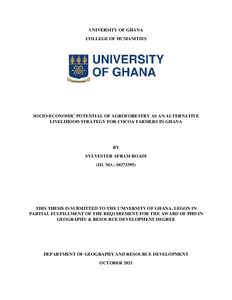| dc.contributor.author | Boadi, S.A. |
| dc.date.accessioned | 2022-09-15T10:26:31Z |
| dc.date.available | 2022-09-15T10:26:31Z |
| dc.date.issued | 2021-10 |
| dc.identifier.citation | Boadi, S.A. (2021). Socio-economic potential of agroforestry as an alternative livelihood strategy for cocoa farmers in Ghana. Accra, Ghana: University of Ghana, (312 p.). |
| dc.identifier.uri | https://hdl.handle.net/20.500.12478/7756 |
| dc.description.abstract | Cocoa (Theobroma cacao) cultivation in Ghana is dominated by smallholder farming households most of whom derive the greater percentage of their incomes from the crop. Changes in climate in addition to inherent boom-and-bust cycles associated with cash cropping is reducing the yielding capacity of cocoa plots and, by extension, household incomes. Current research suggests that the integration of trees and other crops into cocoa plots has the potential to increase the resilience of these farms to climate change, moderate pest and disease infestation, offer more stable yields and incomes, improve plot-level technical efficiency, and contribute to the conservation of forestlands. However, there are few studies with scientifically proven socio-economic models comparing the profitability and technical efficiency of cocoa agroforestry systems to cocoa monocultures. This thesis thus seeks to evaluate cocoa farmers’ current cultivation practices and assess the profitability and technical efficiency of different cocoa systems classified based on the level of tree diversity. Data were collected through household surveys in 402 cocoa farming households and for 1040 cocoa plots in 12 communities across the Transform, Adjust, and Cope climate impact zones in Ahafo, Ashanti, Western North, and Western Regions of Ghana for a normal and a drought year. These zones differ in terms of current and future vulnerability to climate risks. The Transform zone has the highest vulnerability to climatic change. The Adjust zone exhibits moderate vulnerability to climate change, while the Cope zone has the lowest vulnerability. Data were also collected using focus group discussion (FGDs), plot visitation and measurements, and field observations. Guided by a pragmatic philosophical worldview, which encourages the use of pluralistic approaches to gain knowledge on a research problem, the FGDs are analysed using context analysis techniques and combined with the analysis of the survey data to evaluate farmers’ cultivation practices in Ghana. The policy analysis matrix (PAM) model is applied to compare the financial and economic profitability of different cocoa systems, and a stochastic frontier analysis is used to assess the technical efficiency of these cocoa systems. This thesis finds that male headed households maintain significantly higher total number of non-cocoa trees per hectare on cocoa plots (9 trees/ha) than female headed households (6 trees/ha). Also, the study finds that the integration of shade trees in cocoa systems was the most adopted coping measure for managing risks from extreme weather/climate events. One of the major findings of this thesis is that cocoa farmers enjoy consistent and sustained profit in both normal and drought years if they implemented a more tree diverse cultivation system as opposed to a low tree diverse system. Profitability on cocoa plots with low tree diversity was lower even in normal years compared to high tree diversity plots and reduced further in the drought year. The results of this thesis also show that cocoa farmers were producing 22.3% below the levels their current inputs use should yield, and deviations from the optimum production possible were due to factors within the control of farmers. Mean technical efficiency was highest in the Cope zone and reduced as one approaches the drier cocoa belts in northern Ashanti and Ahafo Regions, due mainly to differences in input use efficiency. Based on these findings it is recommended that cocoa farmers consider implementing higher tree diversity levels on their plots especially as changes in climate continue to affect the frequency and magnitude of droughts and dry spells, which as demonstrated in this study affects profitability from low tree diversity cocoa plots. In the Cope zone, medium tree diverse plots are recommended especially since both financial profitability and economic profitability levels started to decline beyond this tree diversity level. |
| dc.description.sponsorship | Ministry of Foreign Affairs of Denmark |
| dc.format.extent | 312 p. |
| dc.language.iso | en |
| dc.publisher | University of Ghana |
| dc.subject | Cocoa |
| dc.subject | Theobroma Cacao |
| dc.subject | Agroforestry |
| dc.subject | Livelihoods |
| dc.subject | Socioeconomic Aspects |
| dc.subject | Smallholders |
| dc.subject | Farmers |
| dc.subject | Ghana |
| dc.title | Socio-economic potential of agroforestry as an alternative livelihood strategy for cocoa farmers in Ghana |
| dc.type | Thesis |
| cg.contributor.affiliation | University of Ghana |
| cg.contributor.affiliation | International Institute of Tropical Agriculture |
| cg.coverage.region | Africa |
| cg.coverage.region | West Africa |
| cg.coverage.country | Ghana |
| cg.coverage.hub | Headquarters and Western Africa Hub |
| cg.researchtheme | Natural Resource Management |
| cg.identifier.bibtexciteid | BOADI:2021 |
| cg.authorship.types | CGIAR and developing country institute |
| cg.iitasubject | Agronomy |
| cg.iitasubject | Climate Change |
| cg.iitasubject | Cocoa |
| cg.iitasubject | Forestry |
| cg.iitasubject | Livelihoods |
| cg.iitasubject | Natural Resource Management |
| cg.iitasubject | Smallholder Farmers |
| cg.iitasubject | Socioeconomy |
| cg.notes | IITA supervisor: Dr. Asare R. |
| cg.publicationplace | Accra, Ghana |
| cg.accessibilitystatus | Limited Access |
| cg.reviewstatus | Internal Review |
| cg.usagerightslicense | Copyrighted; all rights reserved |
| cg.targetaudience | Scientists |
| cg.futureupdate.required | No |

